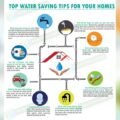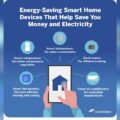Energy efficiency upgrades are one of the most effective ways to reduce energy bills, increase home comfort, and contribute to environmental sustainability.
Also Read
With rising energy costs, homeowners are seeking ways to make their homes more energy-efficient. From small changes like switching to energy-efficient appliances to larger investments like installing solar panels, energy upgrades not only lower your utility bills but also increase the overall value of your property.
In this guide, we’ll explore a range of energy-efficient home improvement ideas, including how to make your home more energy efficient with practical and affordable upgrades. Whether you’re looking to reduce energy costs or simply make your home greener, this guide will walk you through the most impactful changes you can make.
Let’s dive in and see how you can create a more energy-efficient home today.
Affiliate Link: To upgrade your home appliances, check out energy-efficient appliances on Amazon for more affordable options.
Why Energy Efficiency Upgrades Matter
Reducing Energy Costs at Home
Making energy-efficient improvements is a smart investment because it results in significant savings over time. By upgrading to energy-efficient appliances, you can reduce the amount of energy used by common household devices.
Appliances such as refrigerators, dishwashers, and washing machines with the Energy Star rating use less energy while providing the same or better performance.
For example, upgrading to LED lighting instead of incandescent bulbs reduces energy usage by up to 90%, translating into immediate savings on your electricity bills.
Similarly, installing a smart thermostat helps optimize heating and cooling schedules, reducing energy waste and saving up to 15% on HVAC-related expenses.
| Energy Efficiency Benefit | Cost Savings |
|---|---|
| Energy-efficient lighting | Up to 90% savings |
| Smart thermostats | Up to 15% HVAC savings |
| Energy-efficient appliances | Up to 30% lower energy bills |

Increasing Home Comfort
Energy efficiency upgrades not only reduce costs but also improve home comfort. Proper insulation and air sealing prevent drafts, ensuring that your home maintains a consistent temperature year-round.
With better insulation, your heating and cooling systems work more efficiently, eliminating hot and cold spots in your home.
Upgrading windows and doors to energy-efficient models further improves comfort by reducing outside noise, preventing air leaks, and keeping indoor temperatures stable.
Energy-efficient windows, such as double or triple-pane glass, provide better insulation while blocking harmful UV rays that can cause interior fading.
Environmental Impact
Reducing your home’s energy consumption directly contributes to a lower carbon footprint. By installing renewable energy systems like solar panels, you rely less on fossil fuels and reduce greenhouse gas emissions.
Homeowners who prioritize energy efficiency upgrades make a positive environmental impact by lowering their contribution to air pollution and conserving natural resources.
Making energy-efficient changes today will help create a sustainable future for generations to come.
Energy-Efficient Appliances and Lighting
How Energy-Efficient Appliances Work
Investing in energy-efficient appliances is one of the most effective ways to make your home more energy efficient. Energy Star-certified appliances, such as refrigerators, dishwashers, and washing machines, are designed to use less energy than standard models.
These appliances optimize their energy use through features like energy-saving modes and better insulation, all while maintaining high performance.
For instance, an Energy Star-certified refrigerator uses up to 15% less energy than a non-efficient model. Similarly, energy-efficient washing machines use advanced sensors to adjust water levels based on load size, saving both water and energy.
Over time, these savings add up, significantly reducing your utility bills.
Affiliate Link: To upgrade your home appliances, check out energy-efficient appliances on Amazon for more affordable options.
Why Switch to LED Lighting?
Switching to LED lighting is a simple yet powerful way to reduce energy usage in your home. LED bulbs use 90% less energy than traditional incandescent bulbs, and they last up to 25 times longer. This means fewer replacements and lower energy bills.
In addition to energy savings, LED lighting produces less heat, which can reduce the strain on your air conditioning system during the summer months.
For even greater control, smart LED bulbs can be integrated into home automation systems, allowing you to control your lighting remotely or set schedules for when lights should turn on or off.
LED lighting is an easy upgrade that offers significant savings without compromising light quality or brightness.
| Lighting Type | Energy Savings |
|---|---|
| LED bulbs | Up to 90% savings |
| Incandescent | 10% of energy used |

Insulation and Sealing: Key to Reducing Energy Loss
The Importance of Proper Insulation
Proper insulation is essential for maintaining a consistent indoor temperature and improving energy efficiency. By insulating key areas such as the attic, walls, and floors, homeowners can prevent heat from escaping during the winter and keep their homes cool during the summer.
This reduces the need for heating and cooling, which can significantly lower energy bills.
Common types of insulation include fiberglass, spray foam, and cellulose, each offering different levels of effectiveness depending on your home’s needs. For example, fiberglass insulation is ideal for large, accessible spaces like attics, while spray foam is perfect for sealing gaps and hard-to-reach areas.
Air Sealing for Energy Efficiency
Beyond insulation, air sealing is critical for reducing energy waste. Small cracks and gaps around windows, doors, and other areas can lead to air leaks, forcing your HVAC system to work harder.
Caulking and weatherstripping are simple solutions that help eliminate drafts, improve indoor air quality, and increase overall home comfort.
By focusing on both insulation and air sealing, you can reduce energy loss and enhance your home’s efficiency.
Smart Home Technology and Energy Management
How Smart Thermostats Save Energy
Smart thermostats, like the Nest Learning Thermostat, are a game-changer for managing home energy use. These devices use learning algorithms to adjust your heating and cooling settings based on your daily routine, automatically optimizing energy consumption.
With the ability to control smart thermostats remotely via smartphone apps, homeowners can adjust their HVAC systems from anywhere, ensuring that no energy is wasted while they’re away. Smart thermostats can also provide detailed energy reports, helping you track and reduce energy usage over time.
Energy-Efficient Smart Devices
Other smart home devices, such as smart plugs and smart lighting systems, can help you save even more energy. Smart plugs allow you to control when appliances are powered on or off, while smart lighting can be programmed to turn off automatically when not in use.
These devices offer real-time insights into your home’s energy use, helping you make more informed decisions.
By integrating smart technology into your home, you can create a fully automated energy-efficient system that reduces waste and lowers utility bills.
Renewable Energy Solutions: Solar Panels and More
How Solar Panels Save Energy
Solar panels provide a sustainable and long-term solution to energy efficiency. By converting sunlight into electricity, solar panels reduce your reliance on traditional energy sources and lower your electricity bills. Homeowners can save up to 90% on energy costs by installing solar panels.
Although the initial installation costs for solar panels can be high, the return on investment is significant. Many regions offer tax credits and rebates to help offset the upfront costs.
The typical payback period for solar panels is 5-10 years, after which the energy savings continue to accumulate.
| Renewable Energy | Benefit |
|---|---|
| Solar Panels | Up to 90% reduction in electricity costs |
| Geothermal Systems | Efficient heating and cooling |

Other Renewable Energy Options
In addition to solar panels, homeowners can explore other renewable energy sources such as geothermal heating and cooling systems. These systems use the stable temperature of the earth to regulate indoor climates efficiently.
While less common, wind turbines and hydropower systems are also viable options for homes in certain regions.
Water Efficiency Upgrades
Water-Efficient Fixtures and Appliances
Water efficiency is an often-overlooked aspect of home energy efficiency. By installing low-flow faucets, showerheads, and toilets, homeowners can reduce water consumption and lower energy use associated with heating water.
For instance, tankless water heaters provide hot water on demand, eliminating the need to maintain a large hot water tank. This not only saves energy but also reduces water waste. Similarly, water-efficient dishwashers and washing machines reduce the amount of water used per cycle, offering both water and energy savings.
Greywater Systems for Sustainable Water Use
Greywater systems collect and reuse water from sinks, showers, and washing machines for non-potable purposes such as irrigation. These systems reduce the overall demand for fresh water and contribute to both water and energy efficiency.
Affiliate Link: To upgrade your home appliances, check out energy-efficient appliances on Amazon for more affordable options.
Incentives, Rebates, and Financing for Energy Efficiency
Exploring Government Incentives and Rebates
Many governments offer tax credits, rebates, and incentives to encourage homeowners to invest in energy-efficient upgrades. These programs reduce the upfront costs of improvements like solar panels, energy-efficient appliances, and insulation. Research local, state, and federal programs to find rebates for your projects.
Financing Energy Efficiency Upgrades
If you’re planning a major project, you can take advantage of energy-efficient mortgages or green loans. These financing options often offer favorable terms, making it easier to invest in long-term energy savings.
Conclusion on Energy Efficiency Upgrades
Energy efficiency upgrades are a practical way to reduce your energy consumption, lower utility bills, and create a more comfortable living environment.
From small changes like installing LED lights to larger investments like solar panels, these upgrades not only benefit your home but also contribute to environmental sustainability.
With government incentives and smart financing options, making your home more energy-efficient is more accessible than ever.
Whether you’re focused on saving money or reducing your carbon footprint, energy efficiency upgrades are a worthwhile investment for your home and the future.



“Great content, learned a lot from this post!”
Keep up the fantastic work! Kalorifer Sobası odun, kömür, pelet gibi yakıtlarla çalışan ve ısıtma işlevi gören bir soba türüdür. Kalorifer Sobası içindeki yakıtın yanmasıyla oluşan ısıyı doğrudan çevresine yayar ve aynı zamanda suyun ısınmasını sağlar.